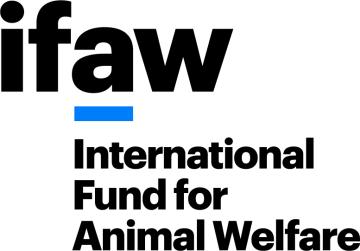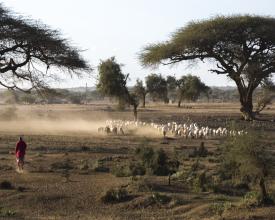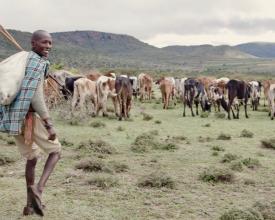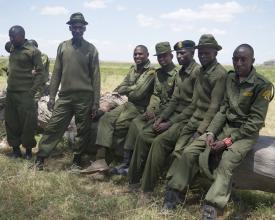
Thriving Together: Achieving the Sustainable Development Goals and Increasing Well-Being for Animals and People

Amboseli National Park is home to some of Kenya’s largest elephant populations. However, the park is small and the elephants require surrounding community lands to fulfill their needs. In 2008, local stakeholders recognized that habitat loss, degradation, and fragmentation would lead to the loss of livelihoods and tourism revenue and opted to ensure the ecosystem’s sustainability. IFAW therefore partnered with relevant stakeholders to secure critical corridors and dispersal areas for elephants in community areas of the Amboseli landscape. To achieve this, IFAW implemented a multi-year commitment to secure 26,000 acres as wildlife migratory and dispersal land in the Amboseli landscape.
Context
Challenges addressed
The Amboseli National Park in southern Kenya is home to Kenya’s largest elephant populations (estimated 2,000) but it cannot support its ecological needs alone. Elephants and other wildlife depend on the surrounding 5,700 kilometers squared of Maasai community land for dispersal and spend up to 80 percent of their time on these community ranches. Specifically, the elephants use thecommunity group ranches as crucial corridors for migration to other protected areas such as Tsavo to the north in Kenya and Kilimanjaro Park to the south in Tanzania. However, in 2008, the main stakeholders and owners of the land – the Maasai group ranches that surround the Park – and the Kenyan government – through its parastatal the Kenya Wildlife Service (KWS) as custodians of the Park – recognized that the threat of habitat loss, degradation, and fragmentation would lead to the loss of livelihoods and revenue from tourism. All issues that IFAW decided to address in this project.
Location
Process
Summary of the process
Incorporating community input in a structured and profound way has led to unique interventions tailored for this specific community and interventions that are sustainable and popular among the community. Therefore, the establishment of the Amboseli Ecosystem Management Plan (AEMP) 2008-2018 has allowed the separation of land use areas for conservation, livestock grazing, farming, and settlement, with the hopes to facilitate human-wildlife conflict mitigation. By securing the Kitenden Corridor, IFAW is helping establish a community conservancy that helps protect, restore, and promote the sustainable use of the Amboseli ecosystem while reversing land degradation and halting biodiversity loss. Through the mapping of wildlife corridors, settlement areas, and potential wildlife threats, the project has secured 26,000 acres of wildlife migratory routes and corridors as well as dispersal areas for the benefit wildlife. This not only benefits the local wildlife, it also has allowed the sustainable development of the community because it also manages the land areas used for farming, settlements, facilities, among others, thus, creating an opportunity for the community to further develop capacity, economic growth and work opportunities.
Building Blocks
Collaboration with the Olgulului Olalarashi Group Ranch and KWS
Amboseli National Park is home to some of Kenya’s largest elephant populations which depend on the surrounding community land for migration. In 2008, the land stakeholders recognized that the habitat loss threats, degradation, and fragmentation would lead to the loss of livelihoods and tourism revenue and opted to ensure the ecosystem’s sustainability. IFAW therefore partnered with relevant stakeholders to secure critical corridors and dispersal areas for elephants in community areas of the Amboseli landscape. To achieve this, IFAW implemented a multi-year commitment to secure 26,000 acres as wildlife migratory and dispersal land in the Amboseli landscape (the Kitenden Corridor, one of the last remaining elephant migratory corridors connecting Kenya and Tanzania).
Enabling factors
The strategy for the leased land was to develop the Kitenden Community Wildlife Conservancy, which will continue to offer a three pronged benefit to wildlife and its habitat, the local community (through eco-friendly, compatible tourism, and enterprise projects), and investors through tourism development and investment. In 2017, IFAW worked with the local Maasai community to register the Kitenden Conservancy Trust - an important step toward securing this portion of land as a community-owned conservancy that supports sustainable livelihoods.
Lesson learned
IFAW partnered with the community of the Olgulului Olalarashi Group Ranch (OOGR, which surrounds 90 percent of the park) in order to ensure that the wildlife protection benefits were connected to human wellbeing improvements. For example, the securing of the Kitenden Corridor would not have been possible without IFAW’s commitment to sign separate agreements with 2,600 indigenous landowners. This has led to remarkable benefits for both the people of the community and the wildlife of the Amboseli National Park. Combining the expertise of science-based wildlife conservation and development initiatives within the community turned out to be essential and should be applied to future projects. Incorporating community input in a structured and profound way has led to unique interventions tailored for this specific community and interventions that are sustainable and popular among the community. Both the local leadership and the community have been heavily involved since the beginning of the project.
Education, training, and other capacity building for the community
IFAW is increasing wildlife security in the Amboseli landscape by equipping community wildlife rangers with expertise and skills through training in human wildlife conflict mitigation and providing operation resources such as rations, salaries, GPS-equipment, uniforms and a patrol vehicle for use by the rangers.
IFAW also initiated an education scholarship to offer financial support to 60 students to pursue studies in high school, tertiary colleges and universities, and 50 community wildlife scouts. By providing education scholarships and wildlife ranger capacity building, IFAW ensures inclusive and equitable education and promotes lifelong learning opportunities and alternative livelihoods for the local community.
IFAW is also working with local women to develop markets for income-generating activities such as beadwork and livestock management. By creating a boarding secondary school for girls and facilitating income generation among women, the project promotes gender equality and empowerment for all women and girls in Amboseli, thus, leaving no-one behind.
Enabling factors
One of the most enabling factors in this project was the fact that the main stakeholders and owners of the land recognized that that habitat loss, degradation and fragmentation was an issue for both widlife and people and that they needed to do something about it.. By partnering up with the OOGR and the KWS, the project ensured community engagement and promotes peaceful and inclusive societies for the sustainable development of the local community and even provides a model to follow for other communities.
Lesson learned
Buy-in from the local communities and the government (KWS) is extremely important to the success of the project. As advice to other implementers, working within existing governmental frameworks can help with implementation. At the same time, working hand and hand with local communities is essential to ensure buy-in and that project activities and interventions are actually leading to desired outcomes.
Rehabilitation of the Northern Water Pipeline
We have identified clean water access as a key goal. Clean water access for humans, livestock, and wildlife will prevent wildlife-related injuries and deaths. In September 2012 IFAW conducted research and helped the county secure funding to rehabilitate the Northern Water Pipeline, which supplies water to communities living in the north of Amboseli. When the project is completed by the end of 2019, it is expected to reliably provide water to 300 homesteads, 3,000 people, and more than 6,000 herds of livestock. By rehabilitating the pipeline, the project ensures availability and sustainable management of clean water and sanitation for the Maasai community, and thus, reducing human-elephant conflict due to water access.
Enabling factors
Participatory community engagement has led to trust within the community for IFAW and the project. Therefore, in-depth participation of community members in the project has allowed for social sustainability. In addition, after substantial investment in education and capacity, the project largely is run by community members who now have the skills to maintain and expand the infrastructure and initiatives. Because of the local capacity, benefits are clearly outweighed by costs.
Lesson learned
A challenge that the project ran into, in particular, was the lack of infrastructure, equipment, and training. Therefore, the project made it a priority to build capacity within the village to build (i.e. the community service center), repair (i.e. the Northern Water Pipeline), or otherwise manage any of the interventions. A lesson that we learned is that it is always better to build capactiy within the community. In our example, not only do local community members now have additional skills they can use on other projects, they have a sense of ownership and pride.
Impacts
The Amboseli Ecosystem Management Plan (AEMP) 2008-2018, was developed after the primary stakeholders of the land recognized that the threat of wildlife and habitat loss was intertwined with the local community’s wellbeing. Specifically, the AEMP separates land use areas for conservation, livestock grazing, farming, and settlement, with the hopes of facilitating human-wildlife conflict mitigation. As of today, Amboseli is the only ecosystem in Kenya with an official management plan. Another intervention – to provide clean water access for humans, livestock, and wildlife – was developed to further prevent wildlife-related injuries and deaths. In September 2012, IFAW conducted research and helped the county secure funding to rehabilitate the Northern Water Pipeline, which supplies water to communities living in the north of Amboseli. When the project is completed in 2019, it is expected to reliably provide water to 300 homesteads, 3,000 people, and more than 6,000 herds of livestock. By rehabilitating the pipeline, the project ensures availability and sustainable management of clean water and sanitation for the Maasai community, and thus, reducing human-elephant conflict due to water access.
Beneficiaries
Aside from wildlife and its habitat, the beneficiaries are the community members of the Olgulului Olalarashi Group Rance who have benefited through employment of community rangers, annual land lease fees, and provision of education scholarships.
Sustainable Development Goals
Story

Through almost 200 women and counting, IFAW is changing the face of conservation. For the first time, the women in the Maasai community feel included in community affairs regarding wildlife conservation – something that was the preserve of men in times gone by. The Maasai community and indeed most traditional settings in Kenya are largely patriarchal. Women are hardly-ever consulted or involved in leadership and decision-making. Time is however slowly changing this as it has become evident that they have a lot to offer.
In the village called Kitirua, almost 200 women have self-organized to form a community group known as the Enduata Kitirua group – Enduata is "vision" in the Maa language; while Kitirua is the village they come from. The group was officially registered in early 2018 and has become an avenue for the women to earn a living through sale of beadwork. They have also started a business to supply, at a profit, community ranger bases with monthly supplies. They are using the proceeds to educate two girls from economically disadvantaged families. According to surveys, these women now see wildlife for its benefit and not as a nuisance stating that wildlife are a tourist attraction and they know that one elephant can educate 100 children through tourism proceeds. The beadwork and supplies businesses have also provided an income for the women to purchase solar-generated hand-held lanterns which they use around the homesteads to not only provide lighting but also keep wildlife away during the night – leading to less cases of predation on livestock. With most of the women never went to school, there is an urgent need for them to be educated on the English or Swahili names of wildlife so that they can effectively communicate them to wildlife rangers who do not speak the Maa language. Plans are under way to partner with the Ministry of Education to translate the names of wildlife from Maa to English and Swahili.


